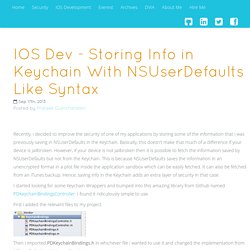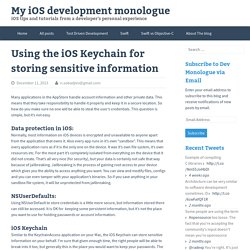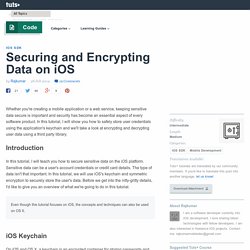

Simple iPhone Keychain Access. The keychain is about the only place that an iPhone application can safely store data that will be preserved across a re-installation of the application.

Each iPhone application gets its own set of keychain items which are backed up whenever the user backs up the device via iTunes. The backup data is encrypted as part of the backup so that it remains secure even if somebody gets access to the backup data. This makes it very attractive to store sensitive data such as passwords, license keys, etc. The only problem is that accessing the keychain services is complicated and even the GenericKeychain example code is hard to follow. I hate to include cut and pasted code into my application, especially when I do not understand it.
IOS Dev - Storing Info in Keychain with NSUserDefaults like syntax - Prateek Gianchandani. Recently, i decided to improve the security of one of my applications by storing some of the information that i was previously saving in NSUserDefaults in the Keychain.

Basically, this doesn’t make that much of a difference if your device is jailbroken. However, if your device is not jailbroken then it is possible to fetch the information saved by NSUserDefaults but not from the Keychain. This is because NSUserDefaults saves the information in an unencrypted format in a plist file inside the application sandbox which can be easily fetched. It can also be fetched from an iTunes backup. Hence, saving info in the Keychain adds an extra layer of security in that case. I started looking for some Keychain Wrappers and bumped into this amazing library from Github named PDKeychainBindingsController. First i added the relevant files to my project. Ios - Difference between Keychain and NSUserDefault? Buzz Andersen — Simple iPhone Keychain Code.
I’ve had occasion to work with Apple’s Keychain security APIs a couple times now (once while developing Cocoalicious, and now for a few iPhone projects I’m working on), and, in terms of complexity of use relative to simplicity of the task at hand, I think it has to be about the worst API I’ve ever encountered.

I’m sure it’s infinitely flexible and capable of doing all kinds of crazy stuff that my non-Lone Gunman brain doesn’t even begin to comprehend, but for me (and I’m guessing 90% of application developers out there), all it really needs to do is let me store a password safely and retrieve it later. Now, it would be one thing if Keychain lacked an intuitive API but at least provided good sample code, but to my mind much of Apple’s relevant sample code, including the GenericKeychain sample app in Apple’s iPhone Developer Program portal, is fairly obfuscated and does little to easily illuminate how a user of the API would accomplish common, concrete tasks.
Storing information in the iOS Keychain. Many applications in the AppStore handle account information and other private data.

This means that they take responsibility to handle it properly and keep it in a secure location. So how do you make sure no one will be able to steal the user’s credentials. This question is simple, but it’s not easy. Data protection in iOS: Normally, most information on iOS devices is encrypted and unavailable to anyone apart from the application that owns it. NSUserDefaults: Using NSUserDefault to store credentials is a little more secure, but information stored there can still be accessed. Using Keychain to Store Username and Password. The keychain services on iOS provide a means to securely store content such as passwords, keys, certificates, etc.
Each iOS application has a separate set of keychain items. Beginning with iOS 3.0, it is possible to share keychain items across applications. In this tip, I will demonstrate a starting point for working with the keychain by storing and retrieving a username and password. Keychain Demo Application Before going any further, let me show you the sample application I wrote to test keychain access.
Below are the definitions for the textfields and the button: Keychain Wrapper Apple has written an Objective-C wrapper that you can use to simplify working with the keychain, the files in the wrapper are KeychainItemWrapper.h and KeychainItemWrapper.m, both are included in the attached Xcode project. To use the wrapper, allocate a new KeychainItemWrapper object as shown below: SaneRSA.h. Objective c - AES Encryption for an NSString on the iPhone.
Iphone - iOS 5: Data encryption AES-256 EncryptWithKey: not found. Securing and Encrypting Data on iOS. Whether you're creating a mobile application or a web service, keeping sensitive data secure is important and security has become an essential aspect of every software product.

In this tutorial, I will show you how to safely store user credentials using the application's keychain and we'll take a look at encrypting and decrypting user data using a third party library. In this tutorial, I will teach you how to secure sensitive data on the iOS platform. Sensitive data can be a user's account credentials or credit card details. The type of data isn't that important. In this tutorial, we will use iOS's keychain and symmetric encryption to securely store the user's data. Even though this tutorial focuses on iOS, the concepts and techniques can also be used on OS X.